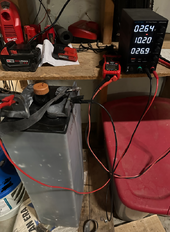DXHum
New Member
- Joined
- Jun 1, 2020
- Messages
- 57
Unfortunately, "set it and forget it" does not apply to lead acid batteries. However, I am guilty of just that.
I've been using Duralast deep cycle marine batteries from AutoZone. And while they work well when fresh and new, I need to learn to keep after them so that they remain reliable and meet expected levels of performance.
So now, I have two Duralast deep cycle marine batteries which I will try to restore.
I've warmed 1 gallon of distilled water in a pot and added a 3 pound bag of epsom salt. Thoroughly stirred and dissolved, I've placed the mixture back in the 1 gallon jug (from distilled water) and set it aside.
I'll have to stop there as my protective face and body wear has not arrived. When it does, I will:
1. Drain all acid from both batteries and store in a bucket.
2. Rinse the battery with fresh water.
3. Using a scope, conduct an internal examination of the battery condition, making any necessary corrections.
4. Filter the used battery acid into a second, clean container.
5. Blend the clean acid with the epsom salt solution.
6. Refill the batteries.
7. Apply the charger ( fill caps off to avoid explosions).
8. Upon reaching voltage, perform a load test.
Anyone else ever try to restore an old lead acid before?
Thank you for input in advance.
Dx
I've been using Duralast deep cycle marine batteries from AutoZone. And while they work well when fresh and new, I need to learn to keep after them so that they remain reliable and meet expected levels of performance.
So now, I have two Duralast deep cycle marine batteries which I will try to restore.
I've warmed 1 gallon of distilled water in a pot and added a 3 pound bag of epsom salt. Thoroughly stirred and dissolved, I've placed the mixture back in the 1 gallon jug (from distilled water) and set it aside.
I'll have to stop there as my protective face and body wear has not arrived. When it does, I will:
1. Drain all acid from both batteries and store in a bucket.
2. Rinse the battery with fresh water.
3. Using a scope, conduct an internal examination of the battery condition, making any necessary corrections.
4. Filter the used battery acid into a second, clean container.
5. Blend the clean acid with the epsom salt solution.
6. Refill the batteries.
7. Apply the charger ( fill caps off to avoid explosions).
8. Upon reaching voltage, perform a load test.
Anyone else ever try to restore an old lead acid before?
Thank you for input in advance.
Dx




